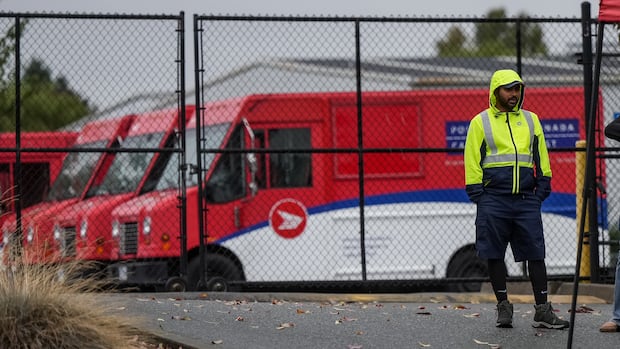CanadaMore than a month into rotating Canada Post strikes, workers and the businesses that use the national postal service are grappling with uncertainty.Workers wait for answers while union, Crown corporation continue negotiationsKevin Maimann · CBC News · Posted: Nov 07, 2025 4:00 AM EST | Last Updated: 3 hours agoListen to this articleEstimated 6 minutesThe audio version of this article is generated by text-to-speech, a technology based on artificial intelligence.A striking Canada Post worker stands at a picket line outside a delivery depot, in Burnaby, B.C. in September. Workers are still waiting on a resolution as their union negotiates with the Crown corporation. (Darryl Dyck/The Canadian Press)More than a month into rotating Canada Post strikes, workers and the businesses that use the national postal service are grappling with uncertainty.Toronto postal worker Helen Karrandjas says she’s feeling frustrated as she waits for a resolution, but for now, everything is “business as usual” for workers. She says the impact of the rotating strikes has been “quite negligible” on the ground. But she also says she can understand why the unpredictability is making some customers nervous, as holiday shopping season kicks into full gear.“At this point, honestly, as a postal worker, I do not want to see any of my customers’ parcels get trapped in the mail system with a late strike,” she said. “With the meetings going on and no news about any negotiations, it’s hard to say what is going to help the situation.”The rolling strikes have so far avoided major urban centres, and most Canadians are still able to send mail and parcels.Karrandjas says workers check the Canadian Union of Postal Workers (CUPW) website every day to see which local is on strike. Several weeks in, she has not had to strike. Right now, she feels the workers don’t have any leverage in the negotiations.CUPW launched a nationwide strike in late September after the federal government announced sweeping changes to the Crown corporation, including authorizing it to end home delivery for the four million addresses that still receive it. The government’s plan also includes lifting a moratorium on closing rural post offices, which covers almost 4,000 locations. CUPW, representing 55,000 postal workers, switched to rotating strikes by Oct. 11, restoring mail service in most places. Workers in parts of Quebec and Ontario have stopped delivering flyers, but continue to deliver addressed mail. But a Retail Council of Canada spokesperson said the “inconsistencies” in the application of the rotating strikes are causing “significant variability” in deliveries across Canada.”This effectively means that service is unreliable and causes considerable frustration for both retailers and Canadian consumers,” spokesperson Santo Ligotti said in an email. “Moving to rotational strikes took the pressure off, but it has changed very little on the ground, and service is severely limited.”Canada Post workers are joined by CUPE union members as they hold a rally outside MP Julie Dabrusin’s office in Toronto in October. (Chris Young/The Canadian Press)Negotiations restarted this weekCUPW said it returned to the negotiating table with Canada Post on Monday for the first time in a month. The two sides have been negotiating a new collective agreement for more than a year and a half.A strike and lockout during the busy holiday period last year lasted more than a month, ending only after the labour minister directed the Canada Industrial Relations Board to order employees back to work under Section 107 of the Canada Labour Code. CUPW and other unions have argued the use of Section 107, which the current Liberal government has invoked several times, violates workers’ charter rights.In February, Canada Post laid off dozens of managers as a cost-cutting measure.The Crown corporation has not turned a profit since 2017, and reported a $1.3-billion loss last year. It says it’s on track to lose $1.5 billion this year, staying afloat with a $1-billion government loan, though CUPW has suggested Canada Post is embellishing some of those numbers.Tuesday’s federal budget made just one mention of Canada Post, saying the government plans to amend the Canada Post Corporation Act to allow the corporation to set postage rates.It’s a change CUPW has long supported, saying low stamp prices are a major cause for the corporation’s financial woes. The company has raised similar concerns. Canada Post preparing for layoffs: profThe union has accused Canada Post and the government of creating the conditions that drive down demand for its letter and parcel services. In September, CUPW rejected the government’s offer of a 13 per cent pay increase, saying it fell short of its demand of 19 per cent. While CUPW said it was willing to work with Canada Post to allow weekend delivery and the addition of part-time workers, it said the corporation walked away from the negotiating table. The union did not provide CBC News with an interview by press time, but said in a statement it is “focused on overcoming disagreements between the parties and advancing negotiations.”A Canada Post spokesperson told CBC News in an email that the corporation is committed to reaching a settlement and understands “the importance of providing certainty for employees and Canadians.”Gilles LeVasseur, professor of management and law at the University of Ottawa, says the rotating strikes are not doing the union any favours and are also harming the Canada Post brand.“It just frustrates the public, or frustrates Canada Post and indirectly the government. And then you get people actually choosing to go somewhere else,” he told CBC News. WATCH | Is there a path forward for Canada Post?:Canada Post is effectively bankrupt. Can it be saved? | About ThatCan ending door-to-door mail delivery help solve Canada Post’s financial crisis? Andrew Chang explains how Canada Post’s strength may now be its weakness — and how a path forward could unfold. Plus, is Trump right about eliminating the penny? But the union has to take action, he says, to showcase to workers that it’s still active and has authority. “It keeps the momentum and keeps the pressure and keeps people believing that something’s going to happen.”LeVasseur says layoffs will be coming alongside the government’s planned changes, but Canada Post needs time to work out exactly what those changes will cost and how many jobs to eliminate. Sorting out the details of ending home mail delivery, setting up new mailboxes, and closing rural post offices could take three or four years, he says. LeVasseur says job security for workers is likely the union’s key negotiating point at this stage.“What Canada Post is going to do is try to get a deal, and then they’re going to make cuts,” he said. “They’re not going to do cuts or reorganization until they close a deal.”ABOUT THE AUTHORKevin Maimann is a senior writer for CBC News based in Edmonton. He has covered a wide range of topics for publications including VICE, the Toronto Star, Xtra Magazine and the Edmonton Journal. You can reach Kevin by email at kevin.maimann@cbc.ca.With files from CBC News
Monday, 22 Dec 2025
Canada – The Illusion
Search
Have an existing account?
Sign In
© 2022 Foxiz News Network. Ruby Design Company. All Rights Reserved.
You May also Like
- More News:
- history
- Standing Bear Network
- John Gonzalez
- ᐊᔭᐦᑊ ayahp — It happened
- Creation
- Beneath the Water
- Olympic gold medal
- Jim Thorpe
- type O blood
- the bringer of life
- Raven
- Wás’agi
- NoiseCat
- 'Sugarcane'
- The rivers still sing
- ᑲᓂᐸᐏᐟ ᒪᐢᑿ
- ᐅᑳᐤ okâw — We remember
- ᐊᓂᓈᐯᐃᐧᐣ aninâpêwin — Truth
- This is what it means to be human.
- Nokoma











